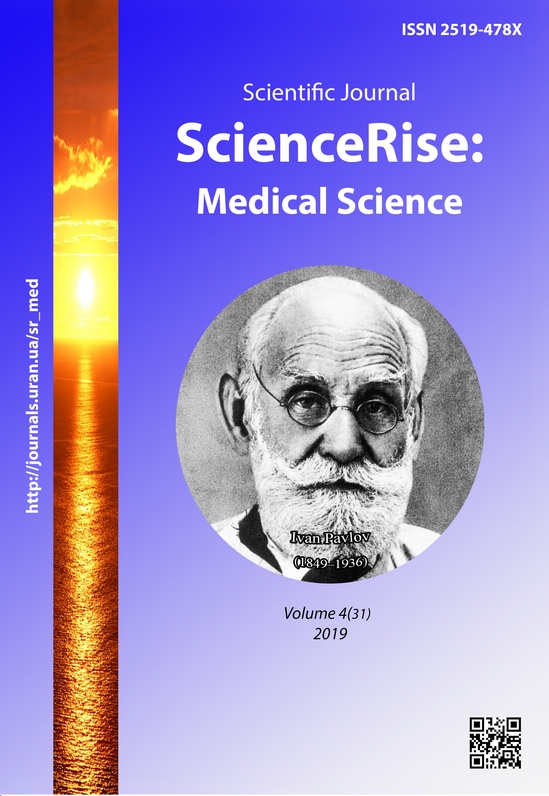Аналіз функціонального стану еритроцитів у хворих з хірургічною патологією аорти після проведеного оперативного втручання з використанням штучного кровообігу (когортне проспективне дослідження)
DOI:
https://doi.org/10.15587/2519-4798.2019.174490Ключові слова:
функціональний стан еритроцитів, хірургічна патологія аорти, штучний кровообігАнотація
Мета – аналіз функціонального стану еритроцитів у хворих з хірургічною патологією аорти після проведеного оперативного втручання з використанням штучного кровообігу.
Матеріали та методи. Обстежено 118 хворих з хірургічною патологією аорти (ХПА). Пацієнти були розподілені на 2 групи. В групу І увійшли 46 пацієнтів, яким додатково призначено розчин меглюміна натрію сукцинат (реамберін), в групу ІІ увійшли 46 пацієнтів, яким додатково призначено розчин D-фруктозо-1,6-дифосфат натрієвої солі гідрату (езофосфіна). Аналізували еритроцитарні індекси: MCV (середній об'єм еритроцита), MCH (середній вміст гемоглобіну в еритроциті), MCHC (середня концентрація гемоглобіну у еритроцитарній масі) і RDW (коефіцієнт середнього обсягу еритроцита).
Результати. При проведенні аналізу динаміки показника ширини розподілу еритроцитів за об'ємом (коефіцієнт середнього об'єму еритроцита) в крові у хворих груп К, І і ІІ не було визначено жодних вірогідних відмінностей між групами. Незважаючи на відсутність статистично значущих відмінностей показника RDW між групами щодобово і в порівнянні з стартовими значеннями, все ж у хворих групи ІІ відновлення його цифр відбувалося швидше в порівнянні з іншими. Враховуючи, що пацієнти групи ІІ відрізнялися за призначення додаткової речовини до основного протоколу лікування - D-фруктозо-1,6-дифосфат натрієвої солі гідрату – можна вважати її фармакодинамічний вплив позитивним на стан розтяжності мембран еритроцитів, їх еластичність і гемолітичну стійкість.
Висновки. Можна стверджувати, що сам по собі факт анестезіологічного забезпечення з використанням ШК негативно впливає на стан еритроцитарних індексів: МСV, МСН, МСНС, RDW. Дослідження дає вектор на призначення під час проведення оперативного втручання додаткових фармакологічних речовин, які б чинили позитивний вплив саме най ці показники
Посилання
- Klimova, B., Valis, M., Kuca, K. (2017). Cognitive decline in normal aging and its prevention: a review on non-pharmacological lifestyle strategies. Clinical Interventions in Aging, 12, 903–910. doi: http://doi.org/10.2147/cia.s132963
- Peracino, A., Pecorelli, S. (2016). The Epidemiology of Cognitive Impairment in the Aging Population: Implications for Hearing Loss. Audiology and Neurotology, 21 (1), 3–9. doi: http://doi.org/10.1159/000448346
- Novak, V., Hajjar, I. (2010). The relationship between blood pressure and cognitive function. Nature Reviews Cardiology, 7 (12), 686–698. doi: http://doi.org/10.1038/nrcardio.2010.161
- Rundshagen, I. (2014). Postoperative Cognitive Dysfunction. Deutsches Ärzteblatt International, 111 (8), 119–125. doi: http://doi.org/10.3238/arztebl.2014.0119
- Jungwirth, B., Zieglgansberger, W., Kochs, E., Rammes, G. (2009). Anesthesia and Postoperative Cognitive Dysfunction (POCD). Mini-Reviews in Medicinal Chemistry, 9 (14), 1568–1579. doi: http://doi.org/10.2174/138955709791012229
- Choi, H. A., Lee, M. J., Chung, C.-S. (2017). Cerebral endothelial dysfunction in reversible cerebral vasoconstriction syndrome: a case-control study. The Journal of Headache and Pain, 18 (1). doi: http://doi.org/10.1186/s10194-017-0738-x
- Hudetz, J. A., Gandhi, S. D., Iqbal, Z., Patterson, K. M., Pagel, P. S. (2010). Elevated postoperative inflammatory biomarkers are associated with short- and medium-term cognitive dysfunction after coronary artery surgery. Journal of Anesthesia, 25 (1), 1–9. doi: http://doi.org/10.1007/s00540-010-1042-y
- Shnaider, N. A. (2007). Rol i mesto farmakologicheskoi tserebroprotektsii v profilaktike i korrektsii kognitivnoi nedostatochnosti: gipotezy i dokazatelstva. Zdorovia Ukraini, 3 (160), 29–30.
- Xu, D., Wang, B., Zhao, X., Zheng, Y., Du, J., Wang, Y. (2017). General anesthetics protects against cardiac arrest-induced brain injury by inhibiting calcium wave propagation in zebrafish. Molecular Brain, 10 (1). doi: http://doi.org/10.1186/s13041-017-0323-x
- Abraham, M. (2014). Protecting the anaesthetised brain. Journal of Neuroanaesthesiology and Critical Care, 1 (1), 20–39. doi: http://doi.org/10.4103/2348-0548.124841
##submission.downloads##
Опубліковано
Як цитувати
Номер
Розділ
Ліцензія
Авторське право (c) 2019 Kyrylo Khyzhniak, Julia Volkova, Kateryna Sharlai

Ця робота ліцензується відповідно до Creative Commons Attribution 4.0 International License.
Наше видання використовує положення про авторські права Creative Commons CC BY для журналів відкритого доступу.
Автори, які публікуються у цьому журналі, погоджуються з наступними умовами:
1. Автори залишають за собою право на авторство своєї роботи та передають журналу право першої публікації цієї роботи на умовах ліцензії Creative Commons CC BY, котра дозволяє іншим особам вільно розповсюджувати опубліковану роботу з обов'язковим посиланням на авторів оригінальної роботи та першу публікацію роботи у цьому журналі.
2. Автори мають право укладати самостійні додаткові угоди щодо неексклюзивного розповсюдження роботи у тому вигляді, в якому вона була опублікована цим журналом (наприклад, розміщувати роботу в електронному сховищі установи або публікувати у складі монографії), за умови збереження посилання на першу публікацію роботи у цьому журналі.










